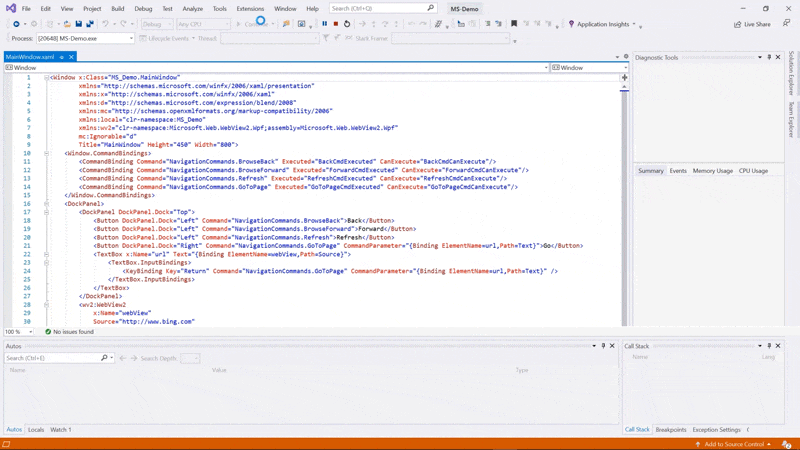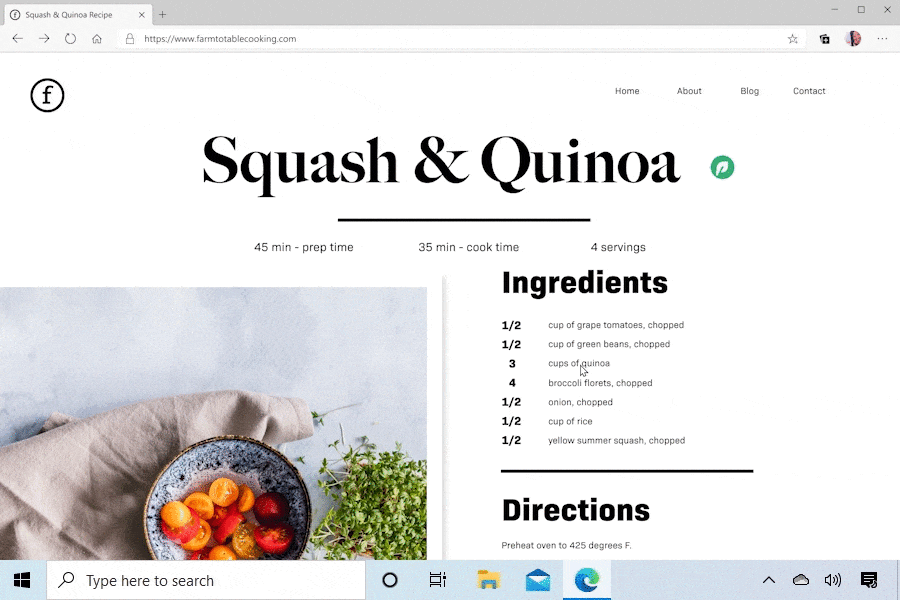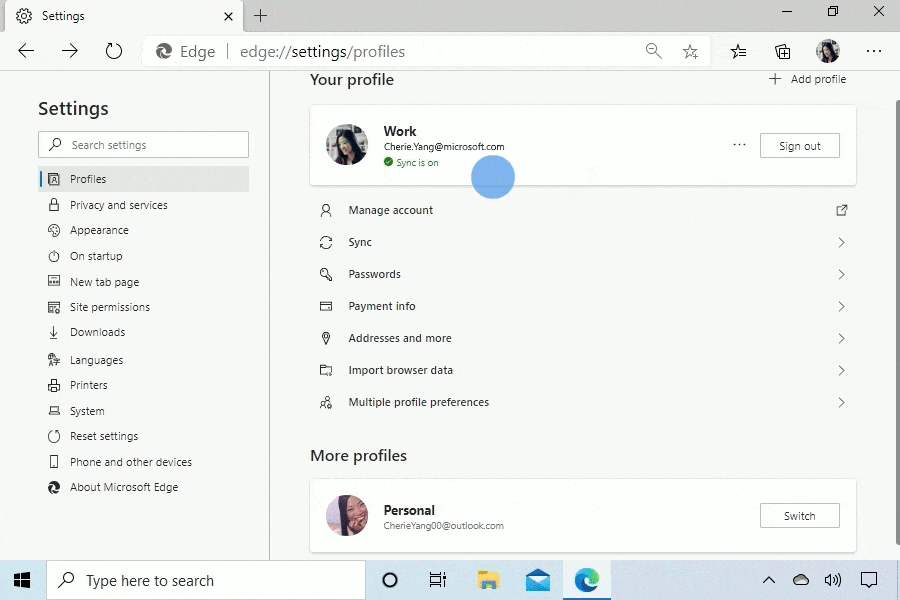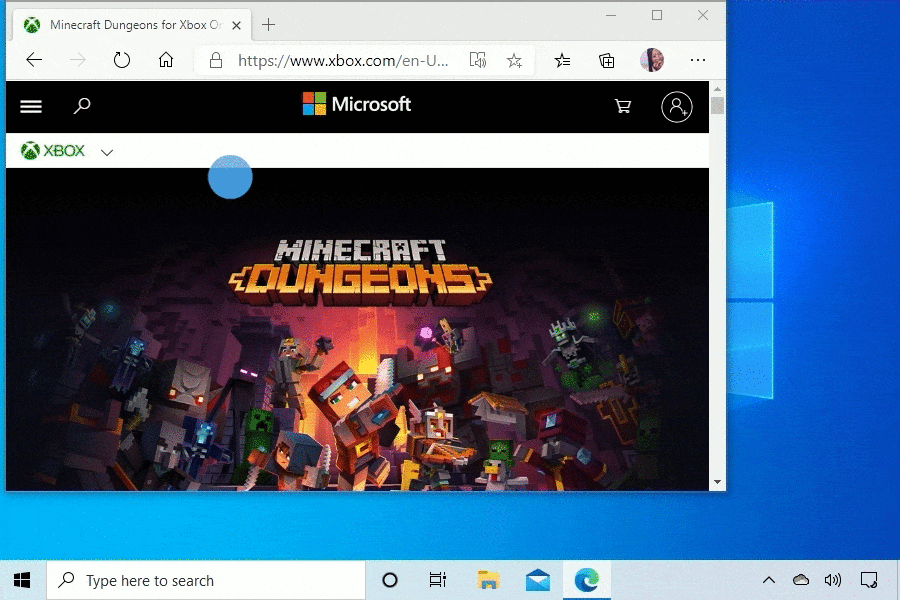Microsoft Build 2020 can be defined by a set of ‘firsts’—it’s the first Build of the new decade, the first Build that’s all-digital for 24 hours a day, and the first Build since the new Microsoft Edge launched! We’re learning a lot as we deliver Build and Microsoft Edge in new ways.
Last year at Build, we unveiled what was coming with the new Microsoft Edge. Since then we haven’t stopped innovating to build a browser that’s right for you, with world-class performance and more security, more productivity, and more value as you browse.
We’ve introduced tools to give you more control over your privacy with Tracking prevention. We’ve added new ways to be more productive with Collections. And with Give Mode, we’ve turned searching with Bing into an easy way to do something good.
As mentioned in January, we plan to upgrade all Windows 10 devices (excluding enterprise and education) to the new Microsoft Edge. Users will be able to experience all the features above when it’s delivered via a measured roll-out that you’ll see ramping up over the course of the next few weeks. If you can’t wait and want to try it now, you can download the new Microsoft Edge here.
We believe in a web that just works for everyone. As we work to deliver a great browsing experience, we remain committed to listening to developers and sharing improvements back to the open source community that makes Microsoft Edge possible. To date, we’ve made over 3,000 commits back to the Chromium open source project that make the web more enjoyable, capable, and accessible for everyone.
This year at Build, we’re sharing ongoing innovation with improved tooling and reach for web developers, new consumer integrations, and new customization options for businesses.
What’s new for web developers
A healthy web community is made possible by a vibrant developer community. Over the last few months, we’ve worked to support that community with improvements like DevTools localization in 10 new languages, which has been adopted by many of you as you develop for Microsoft Edge. Now, we’re excited to highlight new tools that empower you, the developers who make the web possible, while expanding your canvas so you can reach your customers in more ways than ever before.
WebView2 preview expands to include .NET and UWP (WinUI) development

Last year, we pushed WebView2 forward with a preview for Win32 development. WebView2 lowers the barrier for developers to maximize code reuse across platforms with a consistent web platform to host web content in their apps. We’d like to thank everyone that has engaged with us so far throughout the preview—the contributions and feedback we’ve received drive our feature roadmap and quality.
Today, we’re expanding the preview with new options for .NET and UWP (WinUI 3.0) development, enabling you to embed a Chromium-based Edge WebView in WinForms, WPF, and UWP (WinUI 3.0) applications. Check out our documentation and Getting Started guide, or simply open Visual Studio and download the WebView2 package to get started.
Improvements to the Microsoft Edge Add-ons site make searching and finding extensions easier
For many users, extensions are a key component to the web experience. We’re committed to not only making it easy for developers to bring their Chromium-based extensions into our store, but also to make it simple for users to find them. We will be making a significant update to the Microsoft Edge Add-ons site to make it more visually appealing—new categories, new search capabilities, and a new layout will get those extensions in front of customers. Expect to see this roll out starting this month!
Making PWAs feel more at home on Windows 10
Progressive Web Apps (PWAs) continue to gain momentum as a great way to deliver content in an app-like experience across platforms, powered by web standards. With the most recent versions of Microsoft Edge and Windows 10, we’re making PWAs feel even more natural and familiar alongside other Windows apps.
Today, when you install PWAs on Windows 10, they look and feel more at home on your desktop OS in important ways, launching in a standalone window and appearing in places like Start and the Taskbar for easier access. We’re working on updates to make this integration even smoother—you’ll be able to manage them from settings, use them to share (and receive shared content), and more. Check out an early preview of this Windows integration by using Windows Insider preview builds and enabling the Web Apps Identity Proxy flag in the Microsoft Edge Canary preview build.
Try out experimental web platform features with Origin Trials
We always aim to move the web forward to meet the needs of web developers. Our Origin Trials program enables developers to test drive experimental features on their websites for a set length of time. Prototypes that we haven’t enabled for the general web yet will work on your site for a selection of your visitors in Microsoft Edge, enabling you to gather and provide early feedback which can influence the final API.
Learn more and register for an Origin Trial at the new Origin Trial Developer Console today!
New features for every user
This week, we’re also introducing a few exciting new features to help you be more productive, and a new integration to help find and organize the content you want.
Collections in Microsoft Edge is getting smarter with a new Pinterest integration
Collections helps you organize, save, and share your online life by allowing you to create groups of content from around the web. Links, images, text, and notes can be saved together across multiple sites, pages, and browser sessions to help you stay organized and inspired.
Now, Collections in Microsoft Edge is collaborating with Pinterest to help you discover relevant content for your research or project. People use Collections to capture their favorite design ideas, recipes, home improvement links, and even to research their next big purchase across multiple sites. This new integration with Pinterest will help you find ideas to spark inspiration, save time, and be more productive by suggesting content related to what you have already collected. When you enable the feature, you will see Pinterest suggestions at the bottom of your collection. Clicking on a suggestion will open a board of similar, trending Pins so you can quickly find and add ideas relevant to you.
This collaboration also allows you to export your collection to Pinterest. Any saved webpages or images will then show up in a new board in your Pinterest account.

Collections will also be rolling out the ability to send to OneNote, in addition to the options to send to Excel and Word which are available today. Collections integration with Pinterest, and Send to OneNote, will appear in Insider channels within the next month. Join our Edge insider program to be one of the first people to try it.
Sidebar search provides a faster, more contextual way to look things up

Today you have the option to look up words or phrases by searching in a new tab. This can make you lose your train of thought instead of helping you get more out of what you’re reading. Sidebar search aims to improve this experience by giving you the option to see results in a pane on the side of the page. Simply highlight a word or phrase, right click, and select “search in sidebar” from the context menu. And if you’re at work and signed in with your Azure Active Directory account, you’ll even see company results! Reading a corporate strategy paper with unlinked references? Use sidebar search to help find the answer. When you’re done, you can close out of the pane or keep searching in it to look up additional information.
Expect to see this show up in Insider preview channels in the coming weeks. Become an Edge Insider to be one of the first to try it.
New features for information workers and IT Pros
Microsoft Edge is the browser for business, and today we’re announcing new features and updates to make the lives of IT managers and information workers a little bit easier. Want to try these out in your organization? Download offline installers here.
New syncing and customization options for IT professionals

If you use multiple devices while working from home, you know how important sync is. Installed extensions now sync in Microsoft Edge and a new policy even allows IT professionals to precisely manage which types of data sync for their users. The flexibility to sync individual data types means IT professionals can fit syncing to their workplace needs. For some workplaces, syncing passwords might not be allowed—now IT can manage this.
Coming soon, sync will also extend to customers whose environments are still on-premises. The transition to the cloud takes time, and your company should be able to get the most out of Microsoft Edge during that transition.
Data security gets a boost with Windows Information Protection
As many people work from home, data protection is top of mind, especially for IT professionals. Microsoft Edge now supports Windows Information Protection for Windows 10 customers which clearly separates personal and corporate data, adds extra protection for line-of-business apps, and provides audit reporting for compliance. This has been a top ask by many customers, and we’re excited to bring it to the new Microsoft Edge.
Easily move between work and personal profiles

For information workers, we’ve made improvements to help keep them in their flow throughout the workday—this is especially true for those working at home, where work and personal boundaries can easily blend. Microsoft Edge now allows users to set a default profile for any link they open, creating a consistent experience even if they’re switching between profiles throughout the day.
Microsoft Edge helps you manage your profiles even more with a feature called Automatic Profile Switching. Previously, if you’ve been using your personal account and then try to access a work link, you’d be forced to sign-in again because your personal account doesn’t have your work credentials. With the new Automatic Profile Switching feature, Microsoft Edge will detect that the link you’re trying to open needs work credentials, and then switch you to your work profile to open it. Profile switching has never been smoother.
Microsoft Search in Bing puts your work results all in one place
Bing is bringing the life-changing capability of search to the workplace, and we have an exciting update as part of this year’s Build. A comprehensive Work page will now be part of Bing’s search results pages for all Microsoft 365 customers. When signed-in to Bing with your work credentials, this page will appear right next to other familiar pages such as Images, Shopping, and News. This new results page gives you the option to view work-specific results such as files, people, internal websites, and more. If your organization uses Microsoft 365 Apps for enterprise, just sign into Bing with your work credentials and try it today. Learn more on our new website!
We hope you enjoy this new 48-hour, all-digital format as we meet you where you are around the world—we truly can’t thank you enough for joining us online for Microsoft Build 2020.
Keep innovating, keep building, and keep expecting more from the web.

